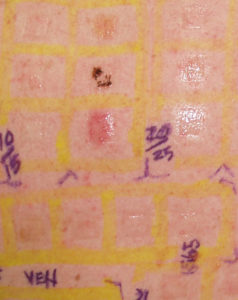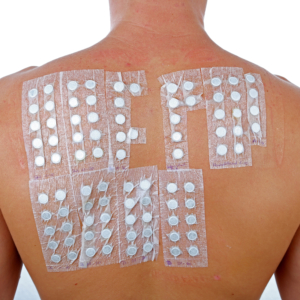ALLERGIC CONTACT DERMATITIS
INTRODUCTION
Allergic contact dermatitis is a red, itchy rash caused by a reaction to a chemical substance that came in contact with your skin. It is not contagious. For some people, the reaction is localized, for example earlobe dermatitis from cheap metal jewelry, and for others it is widespread and debilitating.
There’s a wide range of substances that can cause this reaction– from poison ivy and similar plants, to metals, to ingredients in our personal hygiene products. The allergen chemicals are listed in order from highest to lowest frequency in the ‘I am allergic to’ section under patient education tab. It is important to note that the one thing that holds true for all persons with allergic contact dermatitis (ACD) is that to put the rash into remission, there needs to be avoidance of the chemical substance.
For some, the rash can come and go. The underlying mechanism (immunological-science) is complicated, but it basically boils down to the fact that the more your immune system ‘sees’ the chemical, the more it remembers it. If you wear nickel earrings, a nickel-backed watch, and constantly handle nickel keys, you have three exposures to one basic chemical, nickel. Each time your immune system ‘sees’ the chemical, it can recognize the chemical quicker the next time, your immune system remembers it more. Eventually, people can react to very little chemical stimulation because they have a great memory of it, and sometimes the reactions can be all over the body. In strongly sensitized persons, even food can cause them to react! For example very sensitive people with nickel allergy might react to foods high in nickel (such as chocolate, oats, and legumes (like beans and peanuts).
ALLERGENS
PATCH TESTING
SIMPLE AND FREE
SUPPORT
ALLERGENS
Allergens are ubiquitous compounds that are present in our every day environment. They can be present in nearly every item we come into contact with, including jewelry, soaps, shampoos, tattoos, and even prosthetic joints. Allergens are small substances that are capable of penetrating the skin barrier and bonding with carrier compounds to form haptens. Haptens are what our immune system recognizes as ‘bad’, and forms an immune reaction against it. The initial exposure is sensitizing phase and each subsequent exposure to allergens results in ACD. Each allergic individual represents a unique case of ACD, made up of single or multiple allergies. Unfortunately, there is no ‘cure’ for ACD, however, there are a variety of avoidance and barrier techniques that can be implemented to avoid flares of dermatitis. To recognize these exposures, thorough diligence and investigation is necessary by an allergic individual.
SIMPLE AND FREE
The products listed here have been screened for the top 10 PEDIATRIC contact allergens and their derivatives and cross-reactors*. The Simple and Free™ rating acknowledges the number of products in the line that meet the guideline. Some of these may contain other known contact allergens or ones yet to be identified. It is important to always read the ingredients list and make sure it is the EXACT product name.
The products listed have not been independently evaluated by any medical expert affiliated with Dermatitis Academy to ensure that they do not cause irritation and have been selected based on the manufacturer’s own claims of ingredients and processing.
Certain products listed on our website may include a referral code offer. The seller of the products may provide you with a discount and pay Dermatitis Academy a referral fee for your use of the referral code when you purchase the products.
List of things to do when selecting a product
- Always check the list of ingredients before using a product. If you are allergic to any ingredient on the list, do not use the product.
- Do not rely on the appearance of the label. Read ingredients each time you buy the product.
- Manufacturers are free to change their ingredients at any time. Just because you’ve used a product without any problems, it doesn’t mean that the new one you just bought hasn’t changed.
- Some chemicals have more than one name. Remember this when checking the ingredients list.
- If you develop irritation or rash while using any product, stop immediately, notify your provider and do inform the manufacturer.
PATCH TESTING
Art of Diagnosis
Once it has been determined that you are likely to have ACD by history, then you will be instructed on whether or not you will need a patch test. Since its discovery in 1895, the non-invasive ‘epicutaneous patch test’ has been the gold standard test, the best test to confirm that a patient is sensitized to a chemical.

Positive Patch Test
Who needs a patch test?
In order to confirm the diagnosis of ‘ACD’, your provider will take a thorough history and visualize (see) your rash. Sometimes the association with the allergen chemical is obvious. For example a round patch of rash on the wrist which corresponds to the point of where the back of the watch is releasing nickel suggests the role of the watch, and confirmatory testing will not be needed. In a significant number of cases, however, the rash will come and go and it will be difficult to know what is causing it without a patch test. Many rashes can look like ACD and it is important that your seek evaluation by someone properly trained in the evaluation and management of ACD to determine if a patch test is needed.
How is the patch test done?
The test is not invasive, not painful and takes up 5-7 days to complete. Many insurance companies cover this test and you should check with your insurance carrier before you have the test. The chemicals are applied to the skin on stickers for up to 48hours. They are then removed and the sites checked for ‘early reactions’. The patient then returns in 48-96hours after the removal to have the final reading of the patch tests. All positive reactions are then recorded. The patch test expert will then re-review the patient’s history and correlate it with the positive reactions to see if they can help the patient discover the source of the chemical to which they are reacting. One the source of the chemical is identified and avoided, the rash will go into remission (go away).
What happens after patch testing?
Avoidance of allergen chemicals that the person has reacted to on their patch test (been noted to be sensitized to) is the best method of treatment. However, since the chemicals can activate the skin for weeks after exposure, it is important to maintain strict avoidance for at least 6 weeks. In the meantime, cool compresses, topical anti-inflammatory creams (steroids, topical immune modulators), and antihistamines may be needed, while the rash subsides.
SUPPORT
ACD is a difficult and often debilitating condition to live with. No one should have to face ACD by themselves and we must support one another in our efforts. By joining support groups, we can share information with one another and contributing to discussions about patch testing, allergen avoidance, and provider availabilities. In addition, the ability to report your reaction allows contact dermatitis specialists to garner a greater understanding about the incidence and prevalence of allergic contact dermatitis.




